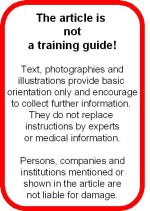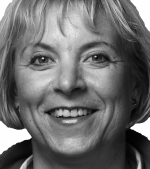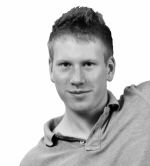1
Muscles for the Ballroom – Fitness Training for Dancesport:
The Thighs.
Text: Kerstin Lange Photography and illustrations: Helmut Römhild
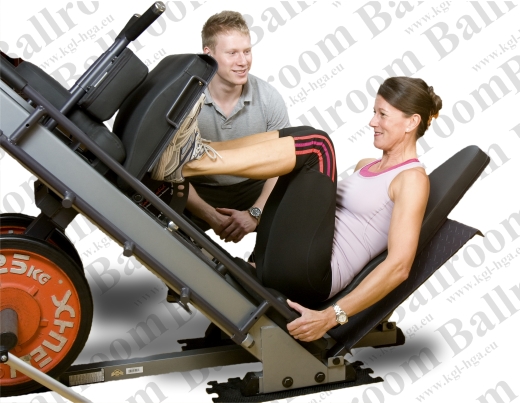
Press ups on a training machine: The workout automatically focusses on the muscles of the thighs while the rest of the body stays relaxed.
Don‘t forget to keep the legs together when bringing the weight down and stop when lower and upper leg
are at a 90 degree angle.
2 minutes of slow walz at competition tempo, 2 minutes of natural turn, change, reverse turn – that means about 60 times
lowering and raising the body to generate and control kinetic energy, or in other words: about 30 knee bends on each leg.
It also means to walk, to stand, to stop, to start. It means to switch from high impact to soft and easy footwork and back: Dancing is done with the legs and means hard labour for the thighs.
‘Flexible knees’ are always ready to raise or lower the body. They are always slightly bent.
Doing this a dancer is more agile, but first and foremost it provides the dancer‘s stability, and again this is accomplished by the thigh muscles.
Unfortunately the thigh muscles differ in size, strength, and performance – a natural disbalance which increases over time and prevents the dancer to
meet the challenges of competition sports.
Thigh muscles can prevent the dancer from moving efficiently and correctly.
The difference in size and strength should be compensated by fitness training, otherwise the muscles will not work together but against each other.
The muscles at the back of the thigh bending the leg are weaker than the muscles in front which extend the leg.
The weaker muscles at the back wear out faster and in the end extension dominates and creates the tendency to dance on rigid legs.
Typical for the muscles at the thigh‘s back is that they become shorter and force their counterparts at the front to work harder and harder.
The muscle at the front of the thigh which extends the leg differs in strengh. The part at the outside of the leg is stronger than the part at the inside, the inner part tending to become weaker over time. Eventually the outside thread pulls the kneecap from its normal position and under the stress of competition dancing the knee starts to hurt.
Workout in Dancesport.
The seemingly effortless way of ballroom dancers to move to the music is a result of considerable fitness. Already the basics of correct posture require strength and an optimised coordination of ligaments,
tendons and muscles.
Dancing alone is not enough to improve strength and mobility.
On the contrary: dancing means to make the system of muscles, tendons, and ligaments work for hours and hours, relentlessly
exploiting the individual possibilities and pushing beyond.
You have to work out to compensate the demands of your sport and to match your rising aspirations as a dancer.
In a short series of articles Ballroom will explain the anatomy involved and discuss exercises to improve
mobility, build up strength, and avoid injuries.
Fitness Trainer Ute Römhild, Trainer Assistant Marc Moder and model Martina contribute expert knowledge and show how to work out effectively.
Incorrectly performed exercises can damage your health!
Consult a fitness instructor before starting to exercise and exercise under supervision of a fitness instructor.
Expert advice is provided by Ute Römhild and Marc Moder.
Ute Römhild
Fitnesstrainer
TSV Glinde von 1930 e.V.
www.tsv-glinde.de
Marc Moder
Trainer Assistant
TSV Glinde von 1930 e.V.
www.tsv-glinde.de
The the pictures were taken at the fitness studio of sportsclub TSV Glinde. We are grateful for the generous support.
TSV Glinde von 1930 e.V.
www.tsv-glinde.de
The muscle in front of the thigh extends the knee joint, the muscles at the back bend the knee joint.
It fully covers the thigh bone from the front.
It consists of 4 threads (or heads) branching from a single tendon. The tendon, attached to the shinbone, runs across the knee towards the thighbone. It encloses the kneecap.
The muscle starts just above the knee, the 4 threads ending at the upper end of the thighbone and at the pelvis.
2 of the hreads run on top of each other in the middle of the thigh, the other 2 at the inside and at the outside of the thigh.
The Quadriceps extends the leg at the kee joint, bends the leg at the hip.
also known as the ‘hamstring’ muscles: The two headed Biceps Femoris, the Semitendinosus and the Semimembranosus which are on top of each other.
One end is connected to the pelvis, the other to the knee area of the lower leg.
They extend the leg at the hip and bend the leg at the knee.
They turn the leg at the joints of hip and knee and pull the leg inward at the hip.
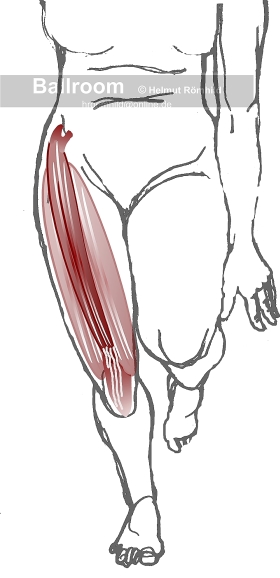
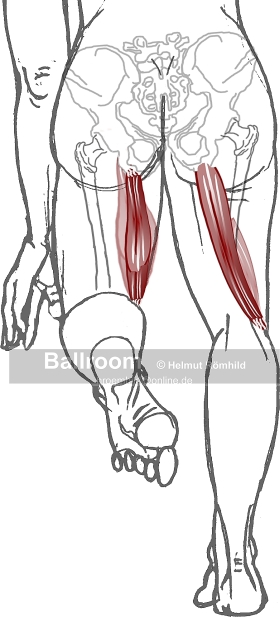
Stretching is most imortant to keep the thigh muscles fit and in shape.
The main goal is to stop the shortening process of the muscles at the back.
There is hardly anything more effective than yoga exercises. They employ the body weight to stretch the massive and strong muscles of the legs.
The forward bend or Uttanasana stretches the muscles at the back of the thigh.
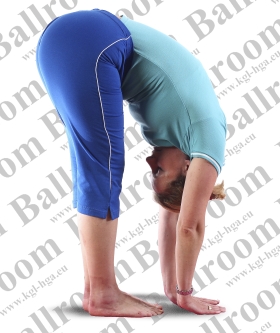
The ‘Child’ pose or Balasana stretches the Quadriceps at the the thigh‘s front.
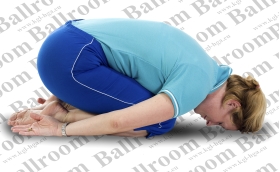
If for example the leg is raised backwards and the foot pulled towards the buttocks the Quadriceps is stretched.
The training of the thigh muscles is necessary to increase strength and agility
and, first and foremost, to prevent certain parts of the muscles to become weaker: the muscle thread at the inside of the front and the ‘hamstring’ at the back.
You don‘t need a machine to work out the Quadriceps – simple knee bends to the job as well.
Just observe the following rules while you lower and raise your body:
| • | Keep the feet flat on the floor. |
| • | Push the buttocks back as if you wanted to sit down. |
| • | Don‘t push the knees beyond the line marked by your toes! |
| • | Keep your back straight, the upper part of your body upright. |
| • | Use your arms to maintain balance. Shift them to the front when lowering the body. |
The exercise machine adjusts the body in an optimal position.
See that most of the body rests on the support including the knees: this is the most effective position. Lower and raise the lower leg, working against a specific weight.
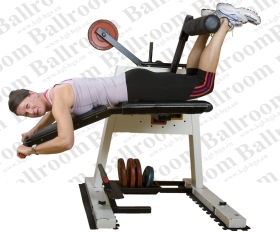
And if there is no machine available?
No problem. Attach an eleastic band to the wall or the door knob.
Lie face down on the floor, put your ankles into the loop of the elastic band,
then lower and raise your lower legs against the pull of the exercise band.
And don‘t forget your knee bends: they also involve the ‘hamstring’ muscles.
![]()
©: Ballroom Website, 2011
Updated: 31.03.2011

